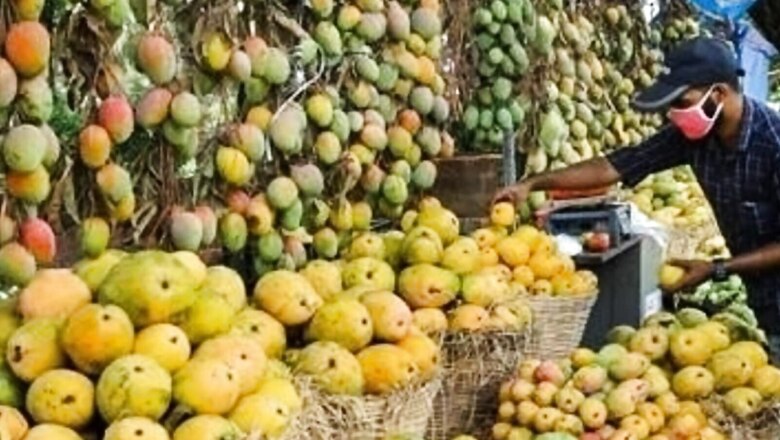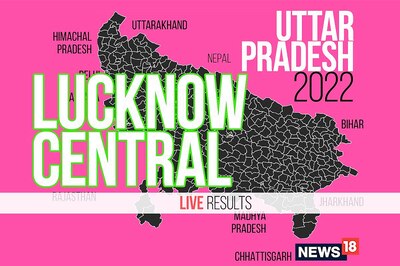
views
The Karnataka government will start delivering mangoes to people’s doorsteps via India Post from today. The scheme, which was conceptualised by the Karnataka State Mango Development and Marketing Corporation Ltd (KSMDMCL) during the pandemic, turned out to be quite a hit as people chose to order their favourite fruit directly from farm to flat. This beautiful golden-coloured fruit packed with sweetness and vitamins binds people across regions with its unique taste, smell and colour — just like our culture and people.
The National Horticulture Board estimates the Indian subcontinent has over 1,500 varieties of mangoes, and each has a unique taste, feel, and style.
News18 takes you through chapters of history and geography to tell you the origins of India?s national fruit.
Alphonso/Badami/Hapus/Apus
Named after the Portuguese Viceroy Afonso de Albuquerque, Alphonso has also earned the title of the ?King of Mangoes?. Famous for its sweetness and fibreless pulp, a hint of acidity gives the fruit its royal touch— making it the most loved and also one of the most expensive varieties of mangoes. Found largely along the western region of India, this variety is available in abundance during the months of April to June.
Badami
A close cousin of the Alphonso mango, this variety is considered the sweetest and most delicious of all. Available between May and July, the fruit finds itself on the plates of all mango lovers right at the beginning of the mango season.
Kesar
From the hills of Junagadh in Gujarat, the sweet and full-bodied Kesar (saffron) is an early arrival in the mango season. The fruit when ripened takes on a beautiful apricot colour with a hint of red blush on the top, giving it the moniker ?Queen of Mangoes?. This variety of the fruit is available in the months of May to July and its excellent sugar-acid blend makes it an absolute relish.
Dasheri or Dashehari
From the Land of the Nawabs, Lucknow, comes Dasheri or Dashehari. This variety of mango was discovered in the early 18th century. It now finds a place in the farms and plates of the southern states of Andhra Pradesh, Kerala, Tamil Nadu and Karnataka as well. Relished for its slight tangy yet sweet taste, this mid-season variety is found in abundance during the months of July and August.
Amrapali
Named after the beautiful courtesan Amrapali, this variety of the fruit is a hybrid between Dasheri and Neelam. It was developed by Dr Piyush Kanti Majumdar at the Delhi-based Indian Agriculture Research Institute in 1971. The first seed of Amrapali was planted in West Bengal and since then this beautiful dwarf hybrid has stolen the hearts of mango lovers. The fruit usually matures towards the end of the mango season.
Himam Pasand/Imam Pasand/Humayun Pasand/Himayat
If Alphonso and Banganapalle are called the ?King of Mangoes?, Himam Pasand, also known as Imam Pasand, is said to be the choice of the royals. Legend says that this lesser-known variety, the sleek, mottled, green-coloured fruit, was originally grown in Kerala and was the Mughal emperor Humayun’s favourite — thus Humayun Pasand. Over time the name lost its reference to be now called Himayat, Imam Pasand or Himam Pasand. It has a unique flavour of sweetness, coconut and a hint of lemon, which makes it a refreshing new variety in the mango family.
Himsagar
This sweet, soft-skinned mango hails from the Nawabi city of Murshidabad in West Bengal. Himsagar is quite difficult to get outside of the state and finds itself sharing a sweet space with other well-known local varieties like Kishan Bhog and Begum Pasand. This variety is available usually during the months of May and June.
Chausa
As its name suggests, this variety of mango falls under the “sucking” category. Sweet, pulpy and small, Chausa is a perfect fit for those who love to eat their mango and have it too! Originating from the Hardoi region of Uttar Pradesh, Chausa has a unique floral taste and aroma.
Langda
This long and pale green-coloured mango hails from the holy city of Varanasi. Its oblong form makes it stand apart from its other sister varieties. Its flesh is fibre-less and the sweet smell of the fruit permeates the air as it ripens. Naturally sugary and soft, Langda (meaning lame) has an interesting fable associated with it. It is believed that 200 years ago, a lame man ate a mango and planted the seed in the ground. He tended to it until it bore fruit and so the villagers named it after him.
Raspuri
Found predominantly in Karnataka’s Ramanagara and Kolar regions, this mango is one of the early varieties that hit the market. Distinguished by its oval shape, its skin, unlike most mangoes, is bitter and almost inedible. The tangy and sweet pulp often makes Raspuri the top candidate while making ice creams, yoghurts, smoothies, juices, jams and jellies. Raspuri usually enters the markets mid-season and lasts till the end of July.
Mankurad
Another gem from the Portuguese orchards, the light yellow yet sweet juicy Goan Mankurad derives its name from the word “Malcorado”, meaning poor coloured. Extremely popular in the coastal state, it is considered one of the sweetest varieties in the region, sometimes better than Alphonso. This mid-season fruit is perfectly sweet and suitably pulpy and hits the markets as early as April.
Gulab Khas
As the name implies, the Gulab Khas mango exhibits a rosy flavour. The fruit has a pinkish-red blush, which adds to its appeal. Found in abundance in Bihar, Jharkhand and West Bengal, Gulab Khas has a special place in the hearts of mango connoisseurs. It is largely available in the period between May and June.
Malgova
Malgova or Malgoa is a round, luscious mango, which retains a green colour with shades of yellow when ripe. Found widely in Tamil Nadu and Karnataka, it is considered to be a variety transplanted from Florida, USA. It is speculated that an American ?Mulgoba? (which may have been misspelt Malgova) was sent from India to the US in 1889 in an effort to introduce tropical fruits in America. It is said that 12 grafted mango trees were shipped by G Marshall Woodrow, a professor of horticulture at the Agricultural College, Poona, to Florida, to be cared for by horticulturists. Ten of the 12 trees died, but two varieties, an Alphonso and a Malgova, survived and bore fruit that year itself. The fruit found its way back into the Indian thali over the years. Lightly sweet, the fruit is roundish-oblique in shape, the pulp is light yellow, and it is mostly available in May and June.
Kilichundan or Totapuri
Named after its form Kilichundan, meaning beak of a bird or parrot in Malayalam, these mangoes herald the entry of summer. Its skin is thick in texture and is best tasted raw or just ripe. This beak-shaped mango finds its niche space amongst the curries, chutneys and buttermilk in the Indian kitchen. Its subdued sourness adds to its popularity and it is relished with a dash of salt and chilli powder. It is usually available most months of the year.
Banganapalle or Safeda
Named after the village of Banganapalle in the Kurnool district of Andhra Pradesh, this mango variety enjoys the same ‘royal’ status as Alphonso, in south India. With a beautiful, thin, yellow skin, this meaty yet firm fruit is filled with sweetness and lacks fibre. Though it is considered a late-season variety, this mango is found most suitable for canning.
Mallika
Famous for its oblong shape and floral aroma, Mallika is also known for its sweet-as-honey and citrus-melon flavour. The saffron-coloured fibreless fruit, just like Amrapali, was developed as a hybrid version of Neelam and Dasheri. It is usually relished towards the fag end of the mango harvest. It is one of the last varieties to be found in the mango markets and also indicates the end of the mango season.
Sadabahar
This is the newest entrant in the mango-sphere. Developed by a Kota-based farmer Shree Kishan Suman, Sadabahar (meaning evergreen) has all the features of the Alphonso mango and scores points when it comes to adaptability, pulp and size. The fruit is sweeter in taste and it is developed as a dwarf variety which makes it suitable for kitchen gardens and can also be grown in pots for the first few years.
Read all the Latest India News here




















Comments
0 comment